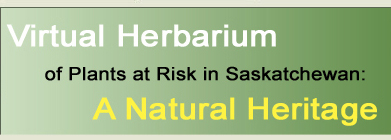|
| Botrychium pedunculosum
W.H. Wagner |
|
| |
| TAXONOMY |
| |
| Family: |
Ophioglossaceae |
| Genus: |
Botrychium |
| |
| Species Synonyms: |
none |
| Common Names: |
stalked moonwort |
| |
| DISTRIBUTION |
| |
| Canada: |
central British Columbia, southwestern Alberta,
southwestern and east-central Saskatchewan |
| Saskatchewan: |
southwestern and east-central Saskatchewan |
| Ecoregion: |
Cypress Upland, Mid-Boreal Lowland |
| |
| HABITAT |
| |
| Saskatchewan: |
open pine or spruce woods on
rotting wood litter |
| Canada: |
bushy habitats along streams
and roadsides |
| |
| RARITY STATUS |
| |
Provincial
Status According
to Harms (2003): |
Endangered |
| Nature Conservancy
Status: |
G2G3 N1 S1 |
Saskatchewan
Species at
Risk Status: |
None |
| COSEWIC Status:
|
None |
| |
| Botrychium pedunculosum
is endangered because of extreme rarity in Saskatchewan and is almost always
locally sparse. No immediate threats are known but are possible in the future. |
| |
| SPECIES
DESCRIPTION |
| |
| Height: |
< 25 cm |
| Stipe: |
common stalk with reddish-brown
stripe |
| Fronds: |
solitary, sterile blade stalk
0.8 – 2.5 cm long, to 1.1 times length of rachis, blade to 4.5 cm
long, 2 cm wide, ovate to oblong, once pinnate, leathery, dull green; pinnae
up to 5 pairs, ascending, approximate to distant, distance between first
and second pinnae equal or slightly greater than between second and third
pairs, basal pinnae equal in size to second pair, ovate to spatulate, venation
pinnate, margin lobed; fertile blades 2 – 4 times as long as sterile
blades, 1 – 3 times pinnate |
| Sporangia: |
short-stalked to sessile on
lateral branches, round |
| Spores: |
small, yellow |
| |
| BOTRYCHIUM
KEY FOR SPECIES FOUND IN SASKATCHEWAN |
| |
| 1 Sterile blades 5 – 25 cm long,
deltate, 2 – 4 times pinnately compound; fertile blades may be absent;
plants over 12 cm tall |
2 |
| 1 Sterile blades 2 – 5 cm long
or absent, oblong to linear or deltate, simple to pinnate or pinnatifed;
fertile blades always present; plants generally less than 15 cm tall |
3 |
| |
|
2 Sterile blades thin; sheaths on
stipe open; fertile blades, when present, arising from high on common stalk;
common stalk usually longer than 10 cm, glabrous
|
B. virginianum |
| 2 Sterile blades herbaceous or thick
to leathery; sheaths on stipe closed; sporophores, when present, arising
from the basal portion of the common stalk; common stalk less than 8 cm
long, somewhat hairy |
B. multifidum |
| |
|
| 3 Sterile blades linear to oblong,
simple to lobed; plants in deep shade under shrubs and trees |
B. simplex |
| 3 Sterile blades linear to deltate,
pinnate or absent; plants usually in exposed sites |
4 |
| |
|
| 4 Distance between first and second
pinnae greater than that between second and third pairs |
B. simplex |
| 4 Distance between first and second
pinnae equal to or slightly more than between second and third pairs |
5 |
| |
|
| 5 Sterile blades present, basal pinnae
fan-shaped to spatulate, midrib absent |
6 |
| 5 Sterile may be replaced by fertile
blade, basal pinnae oblanceolate to linear to ovate, midrib present |
9 |
| |
|
| 6 Sterile blades ovate to deltate |
B. simplex |
| 6 Sterile blades oblong to lanceolate |
7 |
| |
|
| 7 Sterile blades thick and leathery,
dark greyish-green to yellowish; basal pinnae broadly fan-shaped |
B. lunaria |
| 7 Sterile blades thin (except B.
campestre), dark to light green or yellowish; basal pinnae narrowly
fan-shaped or cuneate to linear |
8 |
| |
|
| 8 Sterile blades folded longitudinally,
up to 5 pairs of pinnae; plants of prairies or meadows |
B. campestre |
| 8 Sterile blades flat or folded only
at the base, up to 10 pairs of pinnae; plants of woodlands |
B. minganense |
| |
|
| 9 Sterile blade replaced by fertile
blade, resulting in two fertile blades |
B. paradoxum |
| 9 Sterile blade present, distinct
from fertile blade |
10 |
| |
|
| 10 Sterile blades subsessile, blades
deltate; fertile blades divided equally several times, about equal to 2.5
times longer than sterile blades |
B. lanceolatum |
| 10 Sterile blades ovate to oblong
or deltate; fertile blades with one main axis, 2 – 4 times longer
than sterile blades |
11 |
| |
|
| 11 Sterile blade long-stalked, stalk
equal to length of blade; few sporangia may be present on the basal pinnae
of sterile blade |
B. pedunculosum |
| 11 Sterile blade sessile to short-stalked,
stalk less than ¼ length of blade; sporangia never present on basal
pinnae of sterile blade |
B. hesperium |
|






